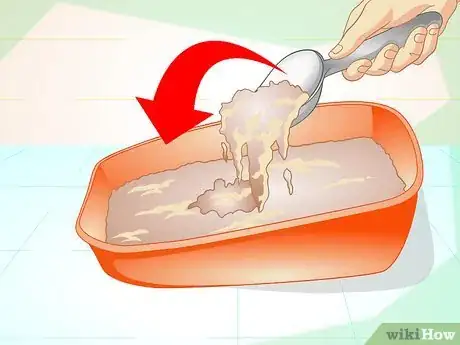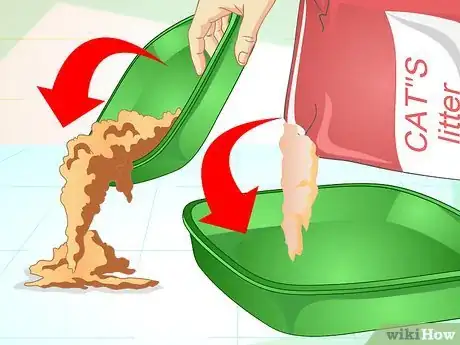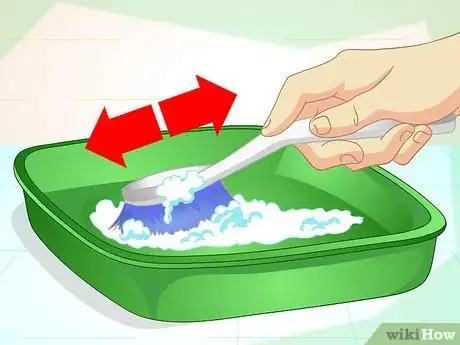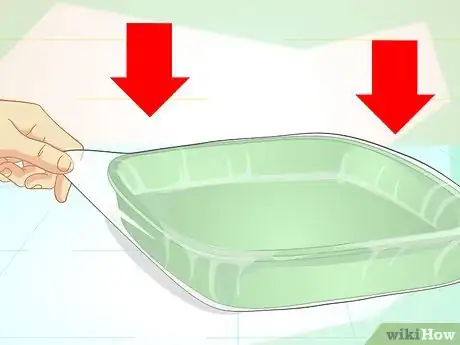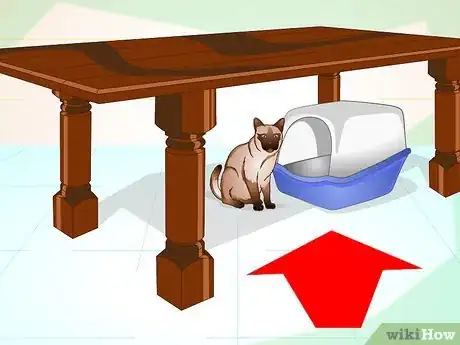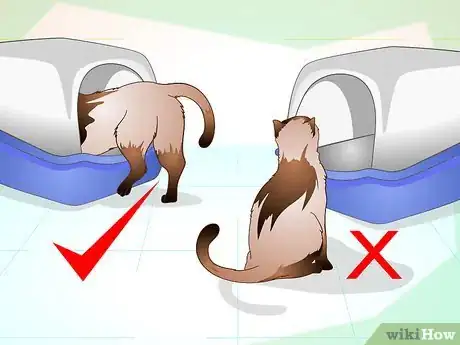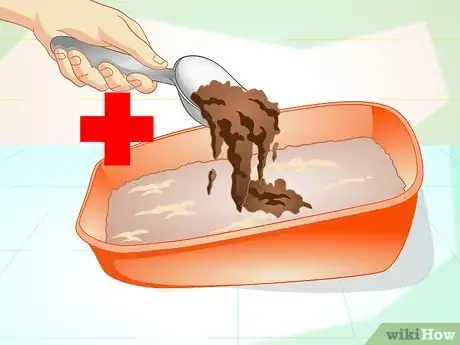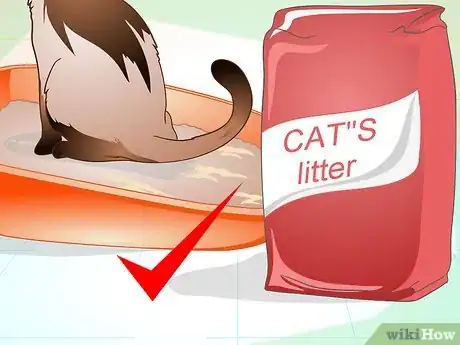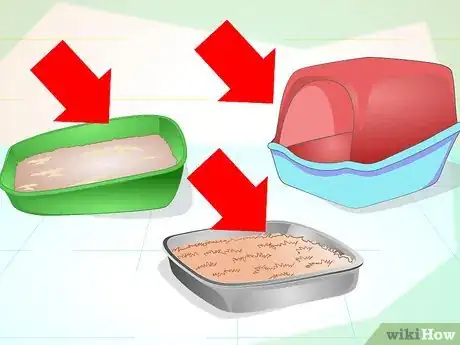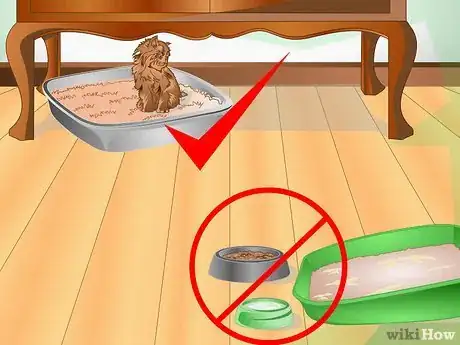This article was co-authored by Carrie Seay, MS-CABAC, KPA-CTP, CBCC-KA. Carrie Seay is a Feline Behavior Consultant and the Owner of Carrie Pawpins based in Phoenix, Arizona. With over a decade of experience, she specializes in working with cat owners to prevent and eliminate cat behavioral issues. Carrie holds a Bachelor’s degree in Biology from Northern Arizona University and a Master’s degree in Companion Animal Behavior Analysis & Counseling from The American College of Applied Science. She has multiple certifications from well-known training programs like Karen Pryor academy.
There are 11 references cited in this article, which can be found at the bottom of the page.
wikiHow marks an article as reader-approved once it receives enough positive feedback. In this case, several readers have written to tell us that this article was helpful to them, earning it our reader-approved status.
This article has been viewed 171,672 times.
Getting a new kitten or cat can be an exciting time. As you and your family get to know your new furry friend, it is important to establish good habits in offering the proper care. Proper care of your cat includes the maintaining of a clean litter box to help keep your cat happy and your house clean.
Steps
Spot-Cleaning the Litter Box Every Day
-
1Try different kinds of litter. When you home the kitten, ask the previous owner what sort of cat litter the kitten is used to, and offering that litter to start with. Some kittens can be very fussy about what they pee and poop on, and you don't want to change too many things for the newbie in the house. Give the kitten a few days to settle in and become confident where the tray is, then you can start to think about changing over litter for whatever reason. Some types of litter are designed to clump or deodorize any smells from your cat's waste. You or your cat may find a certain type of litter to be best. Review the following types of litter to learn which you and your cat may prefer:[1]
- Litter that is safe for kittens. Find a litter that is made of larger, more coarse ingredients such as pine. Many litters will also say “safe for kittens” on the packaging. Some litters however may not be appropriate for kittens, such as clumping-type litters or litters that produce a lot of dust. Clumping-type litters may be ingested by your kitten and can cause stomach discomfort. [2] Overly dusty litters are bad for your kittens lungs and might cause respiratory problems.
- The scoop-able or clumping-type of cat litter. This types makes cleaning easy and requires less thorough replacement than other types of litter. These are also good at reducing the odor and well-liked by most cats.[3]
- Non-clumping litter. This type is good at removing odors and is usually less expensive than the clumping type. However, urine might saturate the litter and cause frequent, full changes of the litter.[4]
- Crystal-based/silica gel litter. This type of litter is highly-absorbent, sucking up moisture, urine, and odor. Once the crystals fully absorb, you will need to change the full amount of litter.[5]
- Plant-based/bio-degradable litter. These may be pine pellets, wheat, and/or corn that neutralize the odors. This type is that it does not create as much dust or tracking as other litters.[6] Plant-based litter may be a safer option for cats with respiratory problems.
-
2Scoop any clumps. Using a scooper made of metal or sturdy plastic, remove all the clumped urine and the feces. Keeping the box free of waste will prevent odors and encourage your cat to use the litter-box.[7]
- Scoop at least once a day, more if you have multiple cats.
- Make sure to remove all waste.
- Clean your scooper to prevent the spread of bacteria.
- For the sake of the hygiene of garbage collectors, put the waste in a dog poop bag and knot it before putting it in the trash.
- If you use flush-able litter, flush waste down the toilet.
- Always wash your hands after cleaning the litter-box.
- You may want to try wearing gloves.
Advertisement -
3Maintain the litter level. After scooping the litter-box or cleaning it, make sure to fill it up with an adequate amount of litter. Your cat may have its own preference when it comes to litter depth, so pay attention to its usage.[8]
- Make sure the litter stays about two inches deep, as most cats prefer this.
- Some cats with long hair may prefer shallower litter.
Replacing the Litter Entirely
-
1Replace the litter. Dump out the old one entirely, replacing with fresh, unused litter. The number of cats you live with, the number of litter boxes available to them, and the type of litter you use, will determine how often you have to replace the litter.
-
2Scrub the box. Every time you replace the litter, wash the box thoroughly. You can use some mild detergent like dish soap and warm water.[11] The packaging labels usually tell you if the product is mild or not.[12]
- Empty all the litter in the box.
- Gather your detergents and a disposable sponge or cloth.
- Avoid using detergents that contain ammonia, bleach, citrus oils or those with strong smell; these substances could turn cats away.[13]
- Some cleaning products, including laundry detergents, toilet-bowl cleaners, and disinfecting wipes, can be toxic to cats.[14] Check the label for any warnings such as “"Keep pets and children away from area until dry”
-
3Consider using a liner. A litter-box liner may make it much easier when it comes time to replace the litter. Litter-box liners are designed to hold the litter, just like a bag, making for easy removal and disposal.
- Use a litter-box liner for easy disposal.
- In many cases, the liner ends up being shredded by cats,
- Some cats hate liners, and the use of them may possibly deter your cat from using the litter box.
Maintaining a Pleasant Litter Box Environment
-
1Purchase a covered litter-box. Covered litter-boxes are a great option to help keep the area surrounding the box clean. Keep in mind the advantages and disadvantages of a covered litter-box:
- The cover may prevent a lot of litter from escaping the box.[15]
- Some cats may even prefer covered litter box.
- You’re more likely to forget to clean because it’s out of your sight.
- It traps more odors inside. Therefore, frequent cleaning is necessary.
- If your cats are large, it may not have enough room.
-
2Consider litter mats. Litter mats are a simple method you can make use of to help contain any mess around the box.[16] They are used to collect any excess litter that you cats may push onto the floor.[17]
- Place the litter mat underneath the litter-box to catch any litter that may fall outside the box.
- Litter mats may be placed just outside of the litter box opening.
- Alternatives to the commercially-available mats are small cuts of carpets, rags or towels.
-
3Keep the litter-box in a quiet place. Cats appreciate a quite, private bathroom experience. Try putting your litter-box in a place that is removed from the busy areas of your house.
- Keep small children away from the litter-box as they may disturb the cat or try to play with the litter-box.
- Avoid interrupting your cat when they are using the litter-box as this may discourage future use.
Troubleshooting Litter Box Problems
-
1Observe your cat. Keep an eye on your cats usage of the litter-box. Notice when they may or may not be utilizing the box. There may be many causes as to why your cat is not using the litter-box, such as:[18]
-
2Adjust to your cats’ needs. There may be a time when your cat refuses any litter you offer. This situation arises most often with outdoor cats. Try the following ideas to get your cat using the litter-box again.[21]
- If your cat used to be an outdoor cat and likes to use houseplants as bathroom, try mixing some potting soil in the litter.
- If your cat rejects all the commercially available litter, sand may work.
- If you have a kitten, consider using non-clumping litter such as a pelleted litter (e.g. newspaper pellets).
- Make sure to discard the entire litter when needed to maintain cleanliness.[22]
-
3Don't buy scented litter. Although convenient, scented litter can deter your cat from using the litter-box. Try some other methods to reduce any unpleasant odors.
- Sprinkle a thin layer of baking soda at the bottom of the litter box.
- Keep up with the cleaning of the litter-box.
-
4Stick to one type of litter. Once you find the one that your cats like, look no further. Switching the litter type may cause your cats to stop using the box. Keep your litter choice as consistent as you can.[23]
- If your favorite type is discontinued, try to make the new one as close as you can to the original.
-
5Provide a sufficient number of litter boxes. One litter box per cat is not always true – in fact, it is often insufficient. The amount you should place in your home depends on the number of cats you live with you. Not having enough litter boxes around your house may result in house soiling.[24]
- If you have more than one cat, provide boxes in several locations so that no one cat has to wait in line.
- The general rule is one box per one cat plus one more.
- Provide at least one litter box on each floor in the house.
- It’s best not to place all the boxes in one location.
- Make it as convenient as you can for your cat to make use of your litter-boxes.
-
6Pick the right type of box. There are many types of litter-boxes to choose from. Most features on litter-boxes are for the owner and some of these features may not be enjoyed by your cat. You may need to try different kinds before finding the right ones for your cats.[25]
- Keep in mind the basic size and shape of the litter-box.
- Research features on litter-boxes such as covers, air purifiers, or built in cleaning mechanisms.
-
7Place litter-boxes in the best places. There are some general rules about where it is best to place a litter-box for your cat. Following these guidelines can help ensure that you cat makes use of the litter-boxes and avoids having accidents.
- Don’t put the litter box close to its food or water.[26]
- Spread the boxes out. If you have multiple boxes, put them apart from each other so that the cat will always have at least one close by.
- Put it in a quiet space. Cats don't like being disturbed while using the bathroom.
- Try to find a place that will make it easy for you to clean it. It may be tempting to put it out of direct sight, however, it then becomes easy to forget to clean it.
Expert Q&A
-
QuestionHow do you keep the cat litter box clean?
 Carrie Seay, MS-CABAC, KPA-CTP, CBCC-KACarrie Seay is a Feline Behavior Consultant and the Owner of Carrie Pawpins based in Phoenix, Arizona. With over a decade of experience, she specializes in working with cat owners to prevent and eliminate cat behavioral issues. Carrie holds a Bachelor’s degree in Biology from Northern Arizona University and a Master’s degree in Companion Animal Behavior Analysis & Counseling from The American College of Applied Science. She has multiple certifications from well-known training programs like Karen Pryor academy.
Carrie Seay, MS-CABAC, KPA-CTP, CBCC-KACarrie Seay is a Feline Behavior Consultant and the Owner of Carrie Pawpins based in Phoenix, Arizona. With over a decade of experience, she specializes in working with cat owners to prevent and eliminate cat behavioral issues. Carrie holds a Bachelor’s degree in Biology from Northern Arizona University and a Master’s degree in Companion Animal Behavior Analysis & Counseling from The American College of Applied Science. She has multiple certifications from well-known training programs like Karen Pryor academy.
Feline Behavior Consultant Take time to deep clean your cat's litter box by scraping out all the leftover litter and washing it out with a little bit of dish soap and some warm water. Then, let it air-dry before refilling it with clean litter.
Take time to deep clean your cat's litter box by scraping out all the leftover litter and washing it out with a little bit of dish soap and some warm water. Then, let it air-dry before refilling it with clean litter. -
QuestionWhat can I use to clean the litter box?
 Carrie Seay, MS-CABAC, KPA-CTP, CBCC-KACarrie Seay is a Feline Behavior Consultant and the Owner of Carrie Pawpins based in Phoenix, Arizona. With over a decade of experience, she specializes in working with cat owners to prevent and eliminate cat behavioral issues. Carrie holds a Bachelor’s degree in Biology from Northern Arizona University and a Master’s degree in Companion Animal Behavior Analysis & Counseling from The American College of Applied Science. She has multiple certifications from well-known training programs like Karen Pryor academy.
Carrie Seay, MS-CABAC, KPA-CTP, CBCC-KACarrie Seay is a Feline Behavior Consultant and the Owner of Carrie Pawpins based in Phoenix, Arizona. With over a decade of experience, she specializes in working with cat owners to prevent and eliminate cat behavioral issues. Carrie holds a Bachelor’s degree in Biology from Northern Arizona University and a Master’s degree in Companion Animal Behavior Analysis & Counseling from The American College of Applied Science. She has multiple certifications from well-known training programs like Karen Pryor academy.
Feline Behavior Consultant Dish soap and warm water will do the trick! You don't have to go out and buy anything super specific.
Dish soap and warm water will do the trick! You don't have to go out and buy anything super specific. -
QuestionMy kitten urinated twice in a minute, a few drops here and a few drops there. Is she being lazy?
 Pippa Elliott, MRCVSDr. Elliott, BVMS, MRCVS is a veterinarian with over 30 years of experience in veterinary surgery and companion animal practice. She graduated from the University of Glasgow in 1987 with a degree in veterinary medicine and surgery. She has worked at the same animal clinic in her hometown for over 20 years.
Pippa Elliott, MRCVSDr. Elliott, BVMS, MRCVS is a veterinarian with over 30 years of experience in veterinary surgery and companion animal practice. She graduated from the University of Glasgow in 1987 with a degree in veterinary medicine and surgery. She has worked at the same animal clinic in her hometown for over 20 years.
Veterinarian What you describe is typical of a cat that has bladder discomfort. Causes of bladder discomfort include urinary infections, stress, and crystals in the urine. If the signs continue she must see a vet urgently.
What you describe is typical of a cat that has bladder discomfort. Causes of bladder discomfort include urinary infections, stress, and crystals in the urine. If the signs continue she must see a vet urgently.
Warnings
- Remember not to punish your cats in any way when they soil in your house. Punishment will not help you or your cats. For persistent problems, contact your veterinarian. You may be referred to an animal-behavior specialist.⧼thumbs_response⧽
- Never use household solvents with the litter tray. The fumes can make your pet ill, and some animals (cats, ferrets, etc) like to chew on their litter tray now and then.⧼thumbs_response⧽
- If your cats begin to have litter problems, such as soiling in the house or not going to bathroom as often as they used to, consult with your veterinarian.[27]⧼thumbs_response⧽
- Some cats’ feces contain Toxoplasma gondii, a parasite that causes a condition called toxoplasmosis. The disease is asymptomatic, causing few serious health problems in most healthy individuals. However, pregnant women and people with compromised immune systems should be careful and avoid cleaning the litter box if possible, as Toxoplasma infection could have serious health consequences for them and/or for the unborn baby.[28]⧼thumbs_response⧽
- If you are pregnant and/or immuno-compromised but cannot find someone else to clean your cats’ litter box for you or consider putting on a pair of rubber gloves and a mask.[29]⧼thumbs_response⧽
References
- ↑ http://www.humanesociety.org/animals/cats/tips/preventing_litter_box_problems.html
- ↑ http://www.petsadviser.com/pet-health/is-clumping-litter-safe-for-kittens/
- ↑ http://www.petmd.com/cat/care/evr_ct_what_is_in_cat_litter
- ↑ http://www.petmd.com/cat/centers/litter/evr_ct_clumping-versus-non-clumping-cat-litter
- ↑ http://www.petmd.com/cat/care/evr_ct_what_is_in_cat_litter
- ↑ http://www.petmd.com/cat/care/evr_ct_what_is_in_cat_litter
- ↑ http://www.animalhumanesociety.org/training/litter-box-101-preventing-and-solving-litter-box-problems
- ↑ http://www.humanesociety.org/animals/cats/tips/preventing_litter_box_problems.html
- ↑ http://www.humanesociety.org/animals/cats/tips/preventing_litter_box_problems.html
- ↑ http://www.humanesociety.org/animals/cats/tips/preventing_litter_box_problems.html
- ↑ www.humanesociety.org/animals/cats/tips/preventing_litter_box_problems.html
- ↑ http://www.humanesociety.org/animals/cats/tips/preventing_litter_box_problems.html
- ↑ Carrie Seay, MS-CABAC, KPA-CTP, CBCC-KA. Feline Behavior Consultant. Expert Interview. 1 March 2022.
- ↑ https://www.aspca.org/pet-care/animal-poison-control/poison-control-okay-or-no-way
- ↑ http://www.humanesociety.org/animals/cats/tips/preventing_litter_box_problems.html
- ↑ Carrie Seay, MS-CABAC, KPA-CTP, CBCC-KA. Feline Behavior Consultant. Expert Interview. 1 March 2022.
- ↑ http://www.animalhumanesociety.org/training/litter-box-101-preventing-and-solving-litter-box-problems
- ↑ http://www.animalhumanesociety.org/training/litter-box-101-preventing-and-solving-litter-box-problems
- ↑ Carrie Seay, MS-CABAC, KPA-CTP, CBCC-KA. Feline Behavior Consultant. Expert Interview. 1 March 2022.
- ↑ Carrie Seay, MS-CABAC, KPA-CTP, CBCC-KA. Feline Behavior Consultant. Expert Interview. 1 March 2022.
- ↑ http://www.humanesociety.org/animals/cats/tips/preventing_litter_box_problems.html
- ↑ http://www.catinfo.org/?link=litterbox
- ↑ http://www.animalhumanesociety.org/training/litter-box-101-preventing-and-solving-litter-box-problems
- ↑ http://www.humanesociety.org/animals/cats/tips/preventing_litter_box_problems.html
- ↑ http://www.humanesociety.org/animals/cats/tips/preventing_litter_box_problems.html
- ↑ http://www.humanesociety.org/animals/cats/tips/preventing_litter_box_problems.html
- ↑ http://www.humanesociety.org/animals/cats/cat_problem_solver/litter_box.html
- ↑ http://www.cdc.gov/parasites/toxoplasmosis/gen_info/faqs.html
- ↑ http://www.cdc.gov/parasites/toxoplasmosis/gen_info/faqs.html


